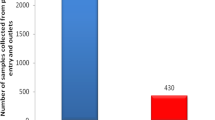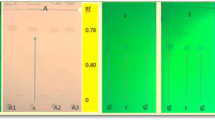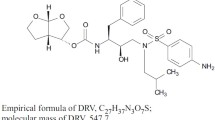Abstract
The global antiretroviral market is expanding dramatically with the approval of competent authorities in individual countries. In India, the Central Drugs Standard Control Organization (CDSCO) and Indian Pharmacopoeia Commission (IPC) are making efforts to approve and set the standards for antiretroviral drugs, respectively. The IPC publishes an official book of standards known as Indian Pharmacopoeia (IP) in fulfillment of the requirements of the Drugs and Cosmetics Act of 1940. There are 41 antiretroviral active pharmaceutical ingredients (APIs) and combinations approved by the CDSCO; the sixth edition of IP contains 52 monographs of different APIs and formulations. The monographs of antiretrovirals include descriptions, identifications, impurities, assays, and specific tests. IP plays a significant role in improving the quality of antiretroviral drugs, which in turn promote public health.
Similar content being viewed by others
References
Waning B, Diedrichsen E, Moon S. A lifeline to treatment: the role of Indian generic manufacturers in supplying antiretroviral medicines to developing countries. J Int AIDS Soc. 2010;13:13–35.
World Health Organization. Towards Universal Access: Scaling Up Priority HIV/AIDS Interventions in the Health Sector. Geneva: World Health Organization; 2009.
Nsimba SE. Problems associated with substandard and counterfeit drugs in developing countries: a review article on global implications of counterfeit drugs in the era of antiretroviral (ARVs) drugs in a free market economy. East Afr J Public Health. 2008;5:205–210.
Caudron JM, Ford N, Henkens M, Mace C, Kiddle-Monroe R, Pinel J. Substandard medicines in resource-poor settings: a problem that can no longer be ignored. Trop Med Int Health. 2008;13:1062–1072.
Gautam CS, Utreja A, Singal GL. Spurious and counterfeit drugs: a growing industry in the developing world. Postgrad Med J. 2009;85:251–256.
Aldhous P. Counterfeit pharmaceuticals: murder by medicine. Nature. 2005;434:132–136.
Newton PN, Green MD, Fernandez FM. Impact of poor-quality medicines in the developing world. Trends Pharmacol Sci. 2010;3:99–101.
Videau JY. Quality of medicines in least developed countries. Med Trop (Maras). 2006;66:533–537.
Ministry of Health and Family Welfare, Government of India. Indian Pharmacopoeia. Ghaziabad: Indian Pharmacopoeia Commission; 2010.
Ministry of Health and Family Welfare, Government of India. Indian Pharmacopoeia. Ghaziabad: Indian Pharmacopoeia Commission; 2007.
Mendez A, Steppe M, Schapoval E. Stability and degradation kinetics of meropenem in powder for injection and reconstituted sample. J Pharm Biomed Anal. 2006;4:1363–1366.
Gorog S. Chemical and analytical characterization of related organic impurities in drugs. Anal Bioanal Chem. 2003;377:852–862.
Qiu F, Norwood DL. Identification of pharmaceutical impurities. J Liq Chromatogr Relat Technol. 2007;30:877–935.
Rao RN, Nagaraju V. An overview of the recent trends in development of HPLC methods for determination of impurities in drugs. J Pharm Biomed Anal. 2003;33:335–377.
Rousseau G. International Conference on Harmonisation impurity guidelines: the industry perspective. Drug Information Journal. 2000;34:903–907.
International Conference on Harmonisation. Q3A(R): Draft Revised Guidance on Impurities in New Drug Substances. Fed Regist. 2000;65(140):45085.
International Conference on Harmonisation. Q3B(R): Draft Revised Guidance on Impurities in New Drug Products. Fed Regist. 2000;65(139):44791.
Mallipeddi R, Rohan LC. Progress in antiretroviral drug delivery using nanotechnology. Int J Nanomed. 2010;5:533–547.
Flora SJS, Mittal M, Mehta A. Heavy metal induced oxidative stress and its possible reversal by chelation therapy. Indian J Med Res. 2008;128:501–523.
Graeme KA, Pollack CV Jr.. Heavy metal toxicity, part I: arsenic and mercury. J Emerg Med. 1998;16:45–56.
Sanjay BB, Bharati RK, Yogini SJ, Atul AS. Impurity profile: significance in active pharmaceutical ingredient. Eurasian J Anal Chem. 2007;2:32–53.
Author information
Authors and Affiliations
Corresponding author
Rights and permissions
About this article
Cite this article
Vivekanandan, K., Sharma, H. & Singh, G.N. Quality Standards for Antiretrovirals in Indian Pharmacopoeia . Ther Innov Regul Sci 46, 581–586 (2012). https://doi.org/10.1177/0092861512450568
Received:
Accepted:
Published:
Issue Date:
DOI: https://doi.org/10.1177/0092861512450568




